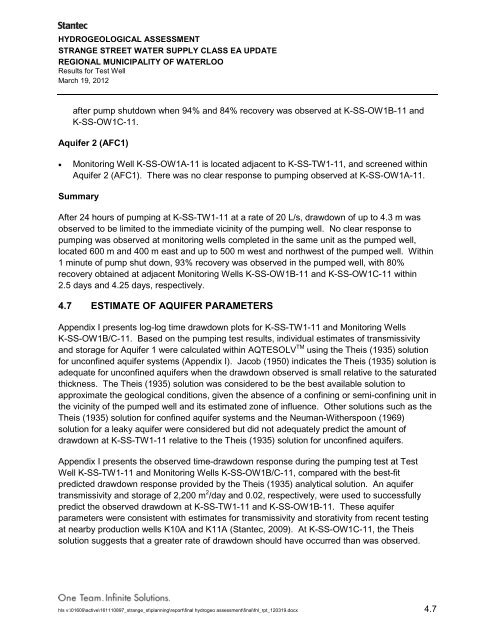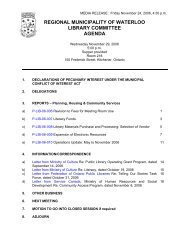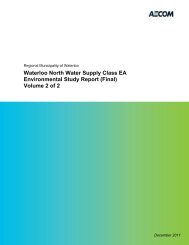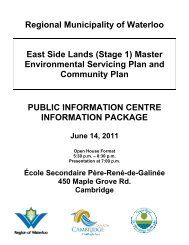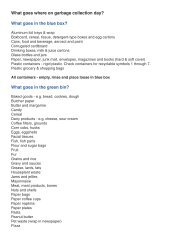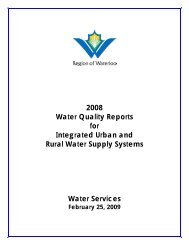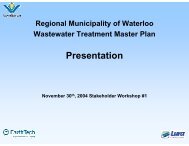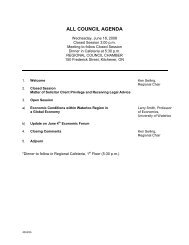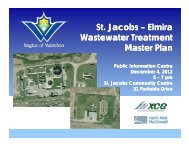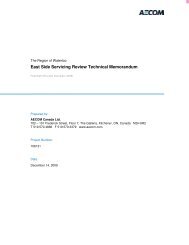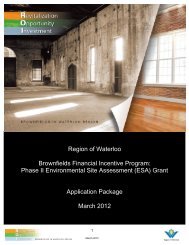Sam Ziemann From - Region of Waterloo
Sam Ziemann From - Region of Waterloo
Sam Ziemann From - Region of Waterloo
You also want an ePaper? Increase the reach of your titles
YUMPU automatically turns print PDFs into web optimized ePapers that Google loves.
HYDROGEOLOGICAL ASSESSMENTSTRANGE STREET WATER SUPPLY CLASS EA UPDATEREGIONAL MUNICIPALITY OF WATERLOOResults for Test WellMarch 19, 2012after pump shutdown when 94% and 84% recovery was observed at K-SS-OW1B-11 andK-SS-OW1C-11.Aquifer 2 (AFC1)• Monitoring Well K-SS-OW1A-11 is located adjacent to K-SS-TW1-11, and screened withinAquifer 2 (AFC1). There was no clear response to pumping observed at K-SS-OW1A-11.SummaryAfter 24 hours <strong>of</strong> pumping at K-SS-TW1-11 at a rate <strong>of</strong> 20 L/s, drawdown <strong>of</strong> up to 4.3 m wasobserved to be limited to the immediate vicinity <strong>of</strong> the pumping well. No clear response topumping was observed at monitoring wells completed in the same unit as the pumped well,located 600 m and 400 m east and up to 500 m west and northwest <strong>of</strong> the pumped well. Within1 minute <strong>of</strong> pump shut down, 93% recovery was observed in the pumped well, with 80%recovery obtained at adjacent Monitoring Wells K-SS-OW1B-11 and K-SS-OW1C-11 within2.5 days and 4.25 days, respectively.4.7 ESTIMATE OF AQUIFER PARAMETERSAppendix I presents log-log time drawdown plots for K-SS-TW1-11 and Monitoring WellsK-SS-OW1B/C-11. Based on the pumping test results, individual estimates <strong>of</strong> transmissivityand storage for Aquifer 1 were calculated within AQTESOLV TM using the Theis (1935) solutionfor unconfined aquifer systems (Appendix I). Jacob (1950) indicates the Theis (1935) solution isadequate for unconfined aquifers when the drawdown observed is small relative to the saturatedthickness. The Theis (1935) solution was considered to be the best available solution toapproximate the geological conditions, given the absence <strong>of</strong> a confining or semi-confining unit inthe vicinity <strong>of</strong> the pumped well and its estimated zone <strong>of</strong> influence. Other solutions such as theTheis (1935) solution for confined aquifer systems and the Neuman-Witherspoon (1969)solution for a leaky aquifer were considered but did not adequately predict the amount <strong>of</strong>drawdown at K-SS-TW1-11 relative to the Theis (1935) solution for unconfined aquifers.Appendix I presents the observed time-drawdown response during the pumping test at TestWell K-SS-TW1-11 and Monitoring Wells K-SS-OW1B/C-11, compared with the best-fitpredicted drawdown response provided by the Theis (1935) analytical solution. An aquifertransmissivity and storage <strong>of</strong> 2,200 m 2 /day and 0.02, respectively, were used to successfullypredict the observed drawdown at K-SS-TW1-11 and K-SS-OW1B-11. These aquiferparameters were consistent with estimates for transmissivity and storativity from recent testingat nearby production wells K10A and K11A (Stantec, 2009). At K-SS-OW1C-11, the Theissolution suggests that a greater rate <strong>of</strong> drawdown should have occurred than was observed.hls v:\01609\active\161110897_strange_st\planning\report\final hydrogeo assessment\final\fnl_rpt_120319.docx 4.7


